Mapping a Logical Problem to a Satoku Matrix
| Author: | Wolfgang Scherer |
|---|
Contents
Logical Problem
The logical problem:
( p ∨ q ) ∧ ( ¬p ∨ r )
is mapped step by step to a satoku matrix SM.
This is the clause vector representation of the base problem:
[ 1 1 _ ] [ 0 _ 1 ] p q r
Satoku Matrix Requirements
The satoku matrix for mapping the logical problem needs 2 clause sub-matrixes S0, S1 with 2 possible selections each.
Mapping the variables to clause sub-matrixes with 2 posssible selections is not necessary, but it facilitates construction of the satoku matrix and better visualizes the problem structure.
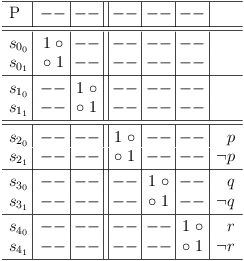
Satoku matrix for representation of (p∨q)∧(¬p∨r)
The logical interpretation of this SM is:
(s00∨s01)∧(s10∨s11)∧(p∨¬p)∧(q∨¬q)∧(r∨¬r)
where s00, s01, s10, s11 stand for not yet specified literals. Adding the tautologies representing the necessary selection of either a variable or its negation does not change the set of possible solutions.
Map Clause (p∨q) Into Clause Sub-Matrix S0
The clause (p∨q) is mapped to clause sub-matrix S0 to illustrate the requirements update algorithm RUA.
Map literal p
Mapping a literal is performed by issuing a request for it. This is achieved by making the selection of the negated literal impossible, which in turn makes the selection of the literal a requirement.
Requesting literal p in clause sub-matrix S0 is performed by making the selection of literal ¬p impossible in clause segment cs00, 2 :
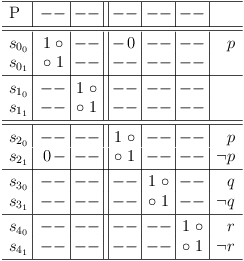
Requirements update for literal p in clause S0 is unspectacular, since there are no conflicts yet:
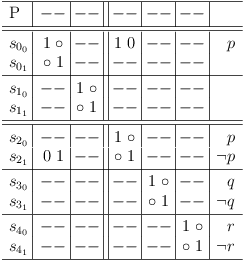
Map literal q
Mapping literal q into clause sub-matrix S0 is more interesting, since it detects consequences beyond the simple selection of the literal.
Request literal q in clause sub-matrix S0 :

Requirements update for literal q in clause sub-matrix S0 : clause segment cs01, 3 :
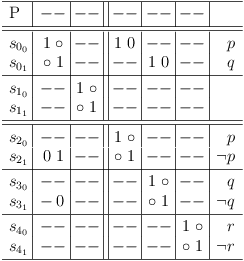
Requirements update for literal q in clause sub-matrix S0 : clause segment cs31, 0 :
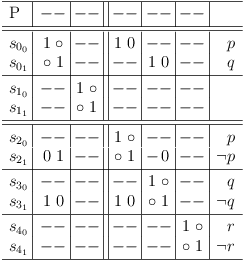
Requirements update for literal q in clause sub-matrix S0 : clause segment cs21, 3 :
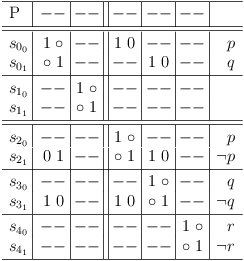
Interpretation of Consequences
The variable representations S2, S3 now show the consequences from the dependencies of clause sub-matrix S0 .
- s21 represents the assignment of truth value F to variable p . The requirements specifiy, that in this case the truth value T must be assigned to variable q .
- s31 represents the assignment of truth value F to variable q . The requirements specifiy, that in this case the truth value T must be assigned to variable p .
Map Clause (¬p∨r) Into Clause Sub-Matrix S1
The mapping of the logical problem is completed by mapping the clause (¬p∨r) into clause sub-matrix S1 .
Request literal ¬p in clause sub-matrix S1 :
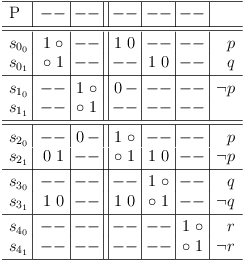
Requirements update for literal ¬p in clause sub-matrix S1 :
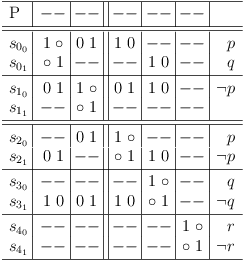
Request literal r in clause sub-matrix S1 :

Requirements update for literal r in clause sub-matrix S1 :
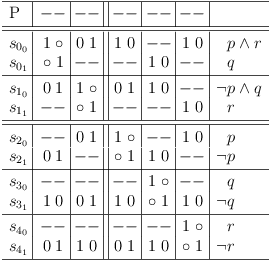
Distributive Expansion
Distributive expansion of a logical problem in conjunctive normal form CNF results in a disjunctive normal form DNF, where each clause represents a partial assignment of variables that solves the problem. All partial assignments are minimal. (Reference: Bronstein).
Distributive Expansion in a Satoku Matrix
Distributive expansion can be performed in a satoku matrix by combining several clause sub-matrixes into a single clause sub-matrix.
Add clause sub-matrix for all possible conjunctive combinations of clause sub-matrixes S0, S1 :
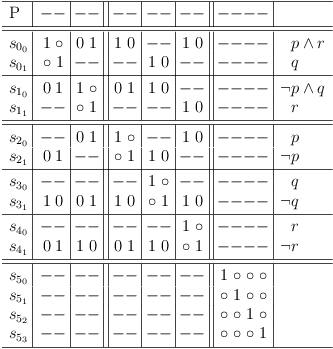
Add duplicate requests for selection rows s00, s01 :
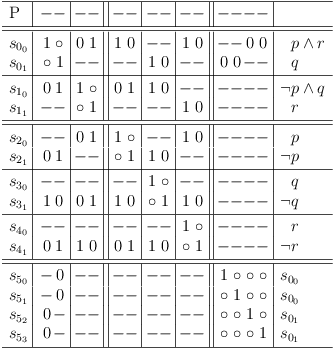
Add duplicate requests for selection rows s10, s11 :
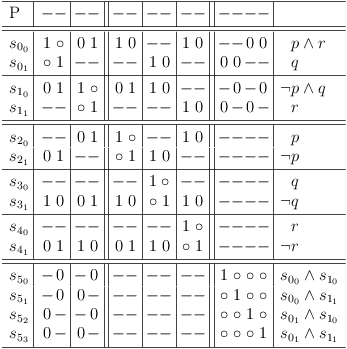
Requirements update:
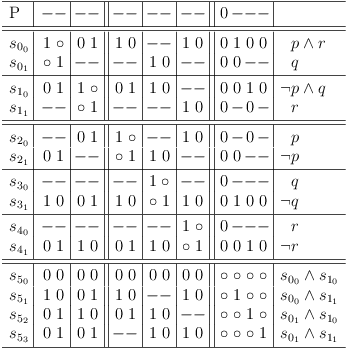
Minimal Conjunctive Assignments
Identify minimal conjunctions:
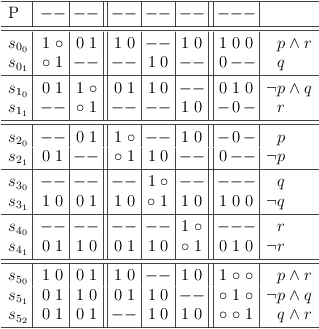
Copyright
Copyright (C) 2013, Wolfgang Scherer, <Wolfgang.Scherer@gmx.de>. See the document source for conditions of use under the GNU Free Documentation License.